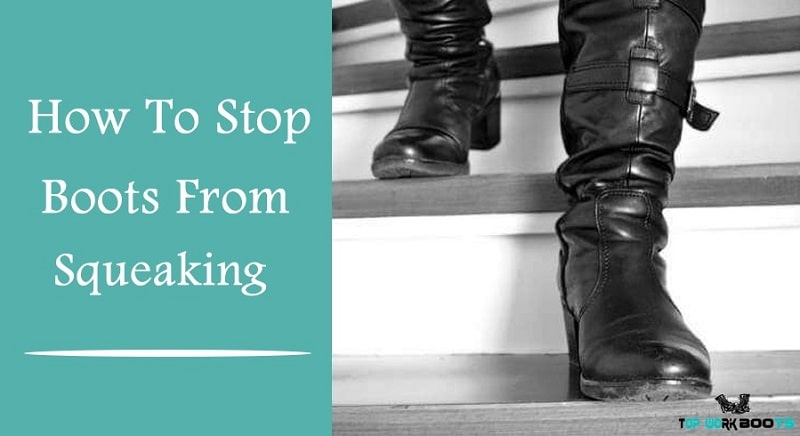How To Stop Boots From Squeaking
by James Miller
Leather is a popular material used in making footwear. Various footwear trends have come and gone, but leather boots never go out of fashion. However, a common issue with leather boots is squeaking as you walk. While squeaky boots are not dangerous for the wearer, they are pretty bothersome and annoying.
Putting up with squeaking boots for some hours is annoying. Many people ignore the squeaky sound and hope it will go away or hope they will get used to it. However, the bad news with squeaking boots is that even if they squeak a thousand times, you will never get accustomed to the annoying sound, and for it to go away, you have to take some action.
At one point or another, you will find yourself online, looking for solutions to your squeaky boots. Of course, before trying to solve the problem, you have to understand why boots squeak and what causes it. Not all shoes squeak, but nearly all boots will squeak, and when this occurs, you are likely to find yourself looking for a solution. So, why do boots squeak?
Contents

Why do Boots Squeak
The squeaking you hear from your boots is sound energy. The sound is created because two or more surfaces are in contact with each other and are vibrating. You might have heard something squeak before, like your car brakes when you are driving. In a car, the brakes should not squeak, and whenever they do, they signify a problem. Friction and stiffness are the two main factors causing your boots to squeak. The following are a few possible reasons why it might happen:
1. You purchased new boots
I can tell you with certainty that your leather boots are not made in one step, as multiple treatments are applied to make them as stiff as woos. As a result of this stiffness, your boots may squeak and you may develop blisters on your feet as a result of this stiffness.
2. Boots squeak when they’re wet
Whenever your boots get wet, you can clearly hear them squeak. The inner lining, soles, and insoles of the boots have spongy materials in them, so they soak up a lot of water.
Water is released when you squeeze the sponge while walking, causing it to squeak.
3. You have worn out your boots for years!
A lot of squeaking is also common with dying boots. A pair of old boots has cracked soles, is stiff, and has loose fitting seams. Squeaking is caused by all of these factors.
4. Manufacturing defects
Manufacturers are sometimes to blame for the problems. Boots are often manufactured in separate parts and are attached separately.
Due to these reasons, air pockets form inside the sole due to which it squeaks.
5. Unsuitable outsoles
It is good for maintaining balance to have outsoles with tread patterns, but the tread patterns create suction when impacted with the ground.
There is a squeaky noise when the suction breaks as you raise your foot to take a step.
Squeaks comes from where?
In my experience, boots squeak the most in three basic areas, which are:
- Boots soles.
- Boots insoles.
- Boots upper.
As explained above, this is because of the same reason. In order to solve a particular problem, one of the following methods must be applied. The methods I’m about to disclose now will help you do that.
How to Stop Boots from Squeaking
Before you start working on any of the ways below, select a working area. You could use your basement or garage; they would be great choices. All you have to do is ensure you have enough space to spread out, and it is easy to clean because there are high chances you will make a mess.
If you do not have space with these features, lay down newspapers or rags on the floor and start working on your squeaky boots.
Talcum Powder
For this, you need talcum powder, corn starch, or baby powder, and glue, which is optional. Keenly examine the inside of the boot and check whether you can remove the lining in it. Some models come with liners, so don’t assume this.
Instructions:
- If liners is removable, take it out and set it aside. By removing it, you will have greater access to the upper area, which joins the sole to the inside part of your boots.
- If your boots are the model without an inner lining, you will have to look for a way to remove the inner sole slowly and tactfully. Once you are done fixing the squeakiness, you will glue it back to the shoe.
- If the idea of removing the inner sole does not sound right to you, then taking it to a cobbler will be the right decision for you.
- After removing the inner sole, apply the talcum powder. You could substitute talcum powder with baby powder or cornstarch- it does not matter the type of powder you use. They will all serve the same purpose and help reduce the moisture between the sole and upper part, allowing the two surfaces to slide against each other and stop vibrating and rubbing.
- Ensure you use enough powder to cover the whole area.
- After applying the powder, leave the shoes to set for at least a day so that the powder can absorb any excess moisture in the shoes.
- After giving the powder enough time to absorb excess water, remove the excess powder. You will do this by knocking the boots from their heels with each other.
- If you have removed the inner lining, glue it back and enjoy your non-squeaky boots. If this doesn’t work, try using a dryer sheet, as explained below.
Dryer Sheet
For this method, you will need a dryer sheet and glue which is optional. The procedure of using a dryer sheet to prevent your boots from squeaking is more or less similar to the one of using talcum powder, but now you will use a dryer sheet or paper towel instead of powder.
Instructions:
- Remove the inner lining of your boots, after which you will place a dryer sheet or paper towel between the liner and the sole.
- Again, the paper towel or dryer sheet will absorb any excess moisture hence preventing the vibrating noise you hear when your boots squeak.
- Ensure the dryer sheet or paper towel is well secured before you leave it to dry.
- After giving it enough time to dry, remove the sheet and place the inner lining back and start walking elegantly as you should.
- Even if the first and second methods do not work for you, do not worry because maybe method three will.
Manually drying the boots
You will need a crumpled newspaper sheet for this method, but if you do not have one, you can work without it. Your boots might be squeaking because there is excess moisture in them and not because of the binding between the sole and the upper part. It is common for moisture to accumulate in shoes after a while, especially in leather, because it is not breathable. The sweaty feet could lead to moisture accumulation.
Instructions:
- To manually get rid of moisture, try hanging them in a dry and warm room.
- To make the drying process even faster, remove the inner lining.
- Hang the shoes by the laces on a coat rack and leave them to dry.
- Do not be tempted to leave your boots in the sun, even if it sounds like a good idea. Remember, the heat from the sun can easily damage leather.
- Hanging them in a warm room away from direct sunlight will do, and the problem will go away.
- Alternatively, you could use old newspapers to dry your boots manually. Old newspapers are always lying around the house, and even if you do not have talcum powder, you are likely to have old newspapers.
- With newspapers, you will fill them in the boots completely such that there is no other space left.
- Leave them like that overnight, and the paper will absorb the moisture from the shoes, similar to how a dryer sheet will.
Oiling
To prevent your boots from squeaking by oiling them, you will have to use either mink oil or coconut oil. Sometimes removing excess moisture from your shoes will not prevent the squeaking sound. It might not even go away by using dryer sheets or talcum powder. The squeaking might be occurring because the leather is rubbing against the sole creating friction.
Instructions:
- You will start by removing the inner lining of the boots, as usual.
- After removing the inner lining, apply coconut oil or mink oil around the joint between the upper section and the sole.
- The oil will lubricate the two surfaces which have been making contact with each other hence reducing the friction between them.
- For the oil to dry naturally, you will want to leave the boots overnight.
- After the oil has dried, place the sole back in the shoes. Even if all the methods fail, oiling your shoes will work.
Not only will these steps nurture your boots, they will also make them more comfortable to wear. I can assure you that there will be no room for squeaking either.
Take Away
Dealing with squeaking shoes can be annoying, and sometimes you can forego wearing your boots because the squeaking sound puts you off. Try using the methods above to prevent your shoes from squeaking, and if none of them works, which I highly doubt, take your shoes to a professional cobbler.
 |
 |
 |
 |

About James Miller
James Miller is a dedicated individual based in the vibrant city of San Francisco, CA, USA. His unwavering passion lies in the realm of construction, where he finds fulfillment in exploring and documenting various facets of construction equipment and processes. A graduate of the University of California Merced, James holds a dual degree in mechanical and electrical engineering, which has equipped him with a solid foundation in technical knowledge.
With a keen eye for detail and a knack for articulation, James has channeled his enthusiasm into writing about the intricacies of construction gear and methodologies. His insightful writings offer valuable insights to both industry professionals and curious enthusiasts, shedding light on the machinery and techniques that shape the built environment.
James Miller's educational background in mechanical and electrical engineering lends credibility to his work, allowing him to delve into the technical nuances of construction with precision. His passion for sharing knowledge and fostering understanding in the construction field is evident in his contributions, making him a respected voice in the industry.
Thoughts on "How To Stop Boots From Squeaking"
 |
 |
 |
 |
Top Boot Reviews
Get FREE Boots Gifts now. Or latest free toolsets from our best collections.
Disable Ad block to get all the secrets. Once done, hit any button below
 |
 |
 |
 |